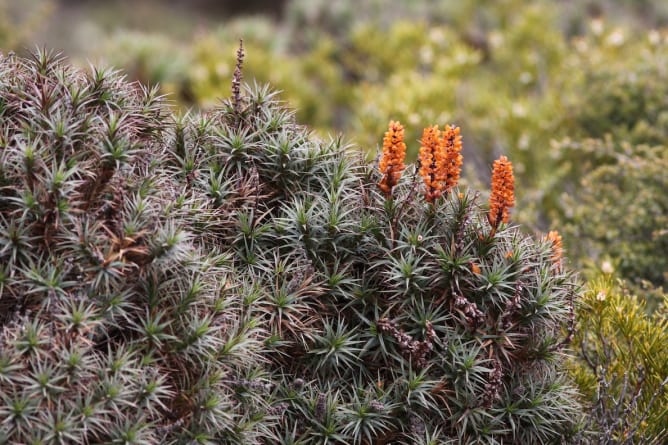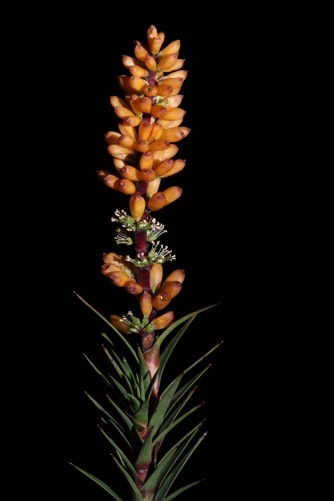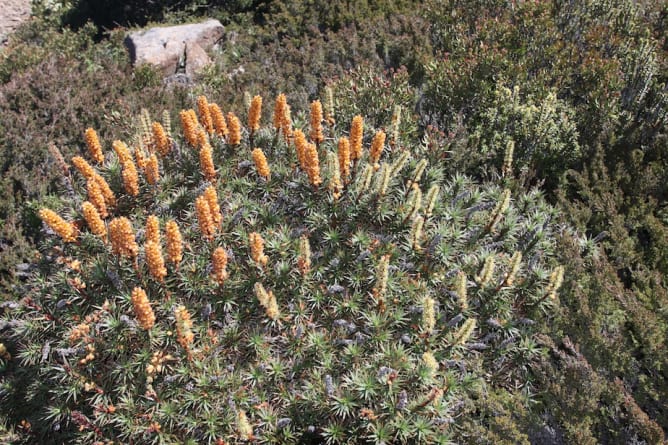
On the Ben Lomond plateau in Tasmania, an alpine wallaby enjoys the morning rays of the spring sun. The cold wind blows harshly in its face, but carries an unexpected, sweet scent of butterscotch. Following the scent the wallaby soon finds itself surrounded by veritable vertebrate snackbars: giant pillows of green shrubs, covered in pink, orange, and red flowers. Small snow skinks scuttle around from twig to twig, and large black currawongs fly overhead. They are all here for the same prize: the hidden, candy-scented nectar of the honeybush.
Why did I end up here?
The project and the story behind this project show different levels: The project started in the office of my supervisor when I was still studying biology. Bouncing back and forth ideas, we came up with scientific questions that I now want to adress to the ecosystem of Tasmania. But I also noticed that many people around me, which had no scientific background, were highly intrested in my ramblings about research and the fascinating stories of interacting plant and animal species. I want to link my fascination and enthusiasm with the passion of an artist. I will be closely working with a wildlife artist from Tasmania, who will accompany me in the field. One further goal is to create an illustrated publication (booklet) and to publish it in a popular journal accesible for everyone.

The wildlife artist Robin Wingrave
Robin Wingrave was born in the United Kingdom in 1968. From a very early age he felt a strong connection to the natural world & would spend all his time sketching the plants & animals in the countryside around his home. This young boy’s hobby would turn into a lifelong passion – one that continues today. Migrating to Australia at sixteen in 1984, Robin settled in North Queensland where he would spend the next twenty four years. His initial works were detailed pencil sketches of the endemic flora & fauna of the wet tropics region he now called home. These works – and people’s reaction to them – were to form the beginning of his career as a serious artist. Starting out in 1999 as the Artist in Residence at the renowned Silky Oaks Lodge in the Daintree region of Northern Queensland, Robin’s work soon became recognised by fellow artists & the local community. In the following years he went on to exhibit at various venues & wildlife orientated conferences in the region. In 2002 Robin was invited to hold his first overseas exhibitions at some of the major zoos in North America. He showcased his work at not only the famous San Diego Zoo, but also the Oregon, Rhode Island & Seattle zoos. These successful exhibitions opened up many new opportunities for future projects. Back in Australia, after some encouragement from a fellow artist, Robin made what was to be a natural transition into both watercolour & oils. In 2004 he travelled as field artist to Papua New Guinea on three expeditions with the Rhode Island based Tree Kangaroo Conservation Program. His work appeared in the book, «Quest for the Tree Kangaroo» and more recently «Kakapo Rescue – Saving The World’s Strangest Parrot». In July 2009 Robin & his wife Sharyn moved from the tropics of North Queensland to the island of Tasmania - a creative hub for many fellow artists. They are currently living in the Launceston area where Robin is tutoring from home & teaching part time in the city.
The scientific background
The honeybush (Richea scoparia, Ericaceae) is a dominant endemic element in the craggy highland heaths of Tasmania, and provides large amounts of a coveted energy source: nectar. But the honeybush is a bit of an introvert. Its nectar smells strongly of butterscotch but is hidden inside corollas that never open (so-called opercula), like wrapped-up candy. Also hidden inside are the reproductive parts of the plant, inaccessible to its comparatively tiny fly pollinators. About twenty years ago, scientists discovered that an unlikely partner provided the ’magic trick’ that unveiled the plant to its pollinators: While studying the ecology of snow skinks, they observed these small lizards eating some of the opercula and their payload of nectar – exposing the anthers and stigma to its fly pollinators. However, the snow skinks only climb the plants on sunny, calm days – rare occasions in alpine Tasmania. We believe science has so far only scratched the surface of the honeybush’s relationship with vertebrate helpers. Recent field observations suggest that a plethora of endemic vertebrates feed on the nectar-filled opercula: Wallabies, currawongs, honey eaters, and snow skinks almost certainly all do, and are potentially joined by nocturnal marsupials, like quolls, antechinuses, and pygmy possums, too.
What is the money used for?
The honeybush goes through exciting stages: From a nectar – snackbar for wallabies to a paradies for insects. And so does this project! After the scientific part is over and done all the enthusiasm will be used to produce the booklet that illustrates my work. I do not need your financial support for the scientific part, but to finance the production of the illustration and to cover the flight expenses to Tasmania. Thanks!











